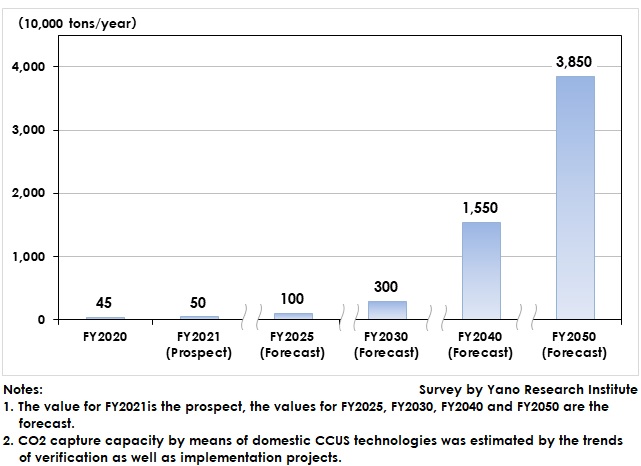No.2963
CCUS (Carbon dioxide Capturing, Utilization or Storage) Technologies in Japan: Key Research Findings 2022
Technological Development and Verification Project on CCUS in Progress, Targeting to Putting into Practice during 2020s
Yano Research Institute (the President, Takashi Mizukoshi) carried out a survey on the domestic CCUS market, and found out the technological trends, trends of market players, and future perspectives. This press release discloses the forecast of domestic CO2 captured by means of CCUS technologies.

Market Overview
The Paris Agreement, concluded to prevent global warming, entered into force in 2016 aims to reduce the global average temperature to below 2 degrees Celsius, preferably to 1.5 degrees Celsius, compared to pre-industrial levels. In Japan, the 2050 Carbon Neutral Declaration has accelerated the movement toward reducing greenhouse gas emissions represented by CO2.
On the other hand, the challenge to overcome is to reduce CO2 emissions from thermal power plants and factories that are projected to be operated as an adjustment of energy. Other than this, in the industries with large CO2 emission capacity such as iron mills, cement plants, refuge incineration equipment, etc. have the similar issues. To address this, CCUS (Carbon dioxide Capture, Utilization and Storage) technologies are in progress for verification projects and development being underway.
There are chemical absorption, physical absorption, membrane separation techniques, etc. in main methods for separating and capturing CO2, which are the core of CCUS technologies. The CO2 capture capacity via CCUS technologies in FY2020 in Japan is estimated to amount to 0.45 MtCO2. It is necessary to establish energy-saving and low-cost technologies to separate and capture CO2, which is in progress via demonstration experiments at domestic companies aiming to make the technologies to be practically implemented during 2020s.
Utilization as resources, underground storage, etc. are the candidate destinations of CO2 after being separated and captured. For instance, there are multiple cases of demonstration experiments for CO2 storage underway in Japan. As to the technologies for effective use of CO2, there are some already commoditized for utilize as a raw material for chemical synthesis of polycarbonate, etc.
Noteworthy Topics
Trends of Direct Air Capture and Other Negative Emission Technologies
In order for realizing carbon neutral, there have been some studies and development in negative emission technologies including DAC (Direct Air Capture) that directly capture CO2 emitted and stored in the air..
The CO2 concentration in the air is around 400 ppm, lower by 2 to 3 digits when compared with the CO2 concentration in the emitted gas of combusted coals or the likes, which is said to make the cost for separating and capturing CO2 extremely high.
Therefore, establishment of the process capable of efficiently absorbing and desorbing large volumes of air in addition to development of higher-performance materials for separating CO2 is necessary to implement DAC. As a trend of component development, solid absorbing materials are considered to be applied for separating and capturing low-concentrated CO2 that are not only in closed space like in a room but also in the air.
Future Outlook
In Japan, in accordance of the progress of verification projects and development of CCUS technologies in 2020s, the number of projects for implementation is projected to increase gradually. The domestic captured capacity of CO2 by means of CCUS technologies is forecasted to expand from 0.5MtCO2PA in FY2021 to 3 MtCO2PA by FY2030 and 38.5 MtCO2PA by FY2050.
When compared to the U.S. that has been leading the world in the CCS (Carbon dioxide Capture and Storage) initiative, Japan has lower potential in storage on land, and most of the CO2 stored is expected to be in marine areas. Therefore, in order to spread the CCUS technologies in Japan, it is indispensable to cultivate carbon recycling technologies as a destination of captured CO2. The full development of CCUS technologies in Japan is expected to be after FY2030 when some of carbon recycling technologies becoming prevalent.
For carbon recycling technologies, cost reduction and technology establishment are projected to press ahead with, in the course of achieving “Roadmap for Carbon Recycling Technologies” planned out by METI.
Research Outline
2.Research Object: R&D institutions studying CCUS technology and businesses offering the technology (engineering manufacturers, machinery manufacturers, power generation operators, etc.) municipalities, fund, etc.
3.Research Methogology: Face-to-face interviews (including online) by expert researchers, and literature research
What is CCUS?
CCUS (Carbon dioxide Capture, Utilization and Storage) technologies are the technologies that separate and capture CO2 included in emission gas from thermal power plants and factories in order to effectively make use of it as a sort of resources for crop production and manufacturing chemical products, or for store it within stable underground stratum.
<Products and Services in the Market>
Technologies for separating and capturing CO2,Technologies for efficient use of CO2, Technologies for storing CO2
Published Report
Contact Us
The copyright and all other rights pertaining to this report belong to Yano Research Institute.
Please contact our PR team when quoting the report contents for the purpose other than media coverage.
Depending on the purpose of using our report, we may ask you to present your sentences for confirmation beforehand.